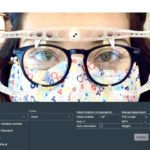By Michele Quintero, OD

July 14, 2021
Changes to how your practice operates can greatly benefit the patient experience and profitability. Here are three of the most effective changes we enacted, including the tremendous impact each made on our patients and practice.
Adding a Digital Measuring Device to Our Optical
Around five years ago we added the ZEISS i.Terminal 2 to our optical, technology that is in the same category as devices like Optikam and Spectangle. We broke even from this investment within the first month of its use in our office.
We wanted a more precise way of taking the measurements needed for digital lenses. We realized we needed to give our patients better, more customized vision with digital lenses. The goal was to increase our sales of digital/anti-fatigue lenses.
The software behind the device costs $2,500-$5,000. After implementing it, we increased our digital/anti-fatigue lens sales by over 40 percent.
We did our research and chose the device that was able to give us all the measurements easily, accurately and quickly to customize our patients’ lenses. An added bonus was the excellent patient education materials included with the app. It allows us to demonstrate the progressive designs and lens treatments to the patient.

One of Dr. Quintero’s staff members demonstrates how the ZEISS i.Terminal 2 works.
It takes staff a few more minutes to show and educate the patient using the app, but patients seem to be impressed by the technology. It also helps to educate patients that more than just a pupillary distance goes into customizing their lenses, which helps discourage the patient from buying online. It takes longer for the staff to get all the needed measurements from the app than it would to take a PD with a pupilometer, but it is definitely worth it to be able to provide higher-quality lenses for the patient.
Patients often say they love the lenses and that they have not seen as clearly in years. Being able to impress the patient with how well they see out of their new glasses helps to generate word-of-mouth referrals, and in turn, has a positive impact on the practice financially.
Empowering Staff
Around four years ago, after opening my second practice, I decided I wanted to empower my staff to make decisions without needing to ask for permission or approval. This change was made for two reasons:
1. To keep my sanity. It was becoming too time consuming and taxing on me to deal with every problem.
2. To show employees that I believe in and trust them.
The goal was to empower the staff to think on their feet, and for me to come up with ways to improve their problem-solving skills.
We set a goal for managing all problems: to make the patient happy. We did role-playing using hypothetical scenarios and delivered staff training to address the areas of weakness we discovered. I told employees that whatever the problem was, if they could make the patient happy by costing us a minimal amount of money, to just do it. They do not have to have my permission first, just make the patient happy.
I told staff members they could “spend” up to $100 to keep the patient happy before needing to ask my permission. This approach to delegation was something I learned at my fourth-year externship site during optometry school.
There is a cost of $100 per incident, but often staff are able to satisfy patients without having to spend the entire $100. For example, if a patient is unhappy with a frame and wants to change it, if the cost to us is $100 or less, the staff is allowed to accommodate the patient with new frames without having to come to me first. There is a cost to us, but if it means keeping the patient from requesting a refund, then it is worth it.
Other Articles to Explore
Patients are happy because they get what they want, employees are happy because they get to help the patient and know that I trust them, and I am happier not having to deal with the minutia of running a practice. We have noticed an increase in our word-of-mouth referrals at both practices since taking the staff empowerment approach.
This is just one of the things we do that helps us retain patients, which has a positive impact on our bottom line in the long run.
Implementing an In-office Communication System
We needed a way to enhance communication between staff members and between doctor and staff quickly and subtly enough to not interrupt patient flow. We hoped to improve intra-office communication.
The Slack app provided us with a solution. However, we are careful not to refer to patients by name to maintain HIPAA compliance. Slack was simple to download and install on our computers.
The version we use is free, but there is a paid version that is HIPAA-compliant if you plan to use the app to discuss patient details.
Slack greatly improved communication and helps ensure we stay on top of everything needed to give the patient a great experience in our office. For example, if the patient is indecisive during refraction, as soon as I have finished the patient’s subjective refraction, I send a message to the optician telling them to have the prescription in the trial frame ready to go as soon as the patient comes out of the exam room, so the patient is not kept waiting. Respecting patients’ time is an important part of creating a winning experience that brings them back every year to the practice.
 Michele Quintero, OD, is the owner of two cold-start practices: Lakeshore Eye Care located in Cypress, Texas, and Advances in Vision located in Houston.
Michele Quintero, OD, is the owner of two cold-start practices: Lakeshore Eye Care located in Cypress, Texas, and Advances in Vision located in Houston.

























